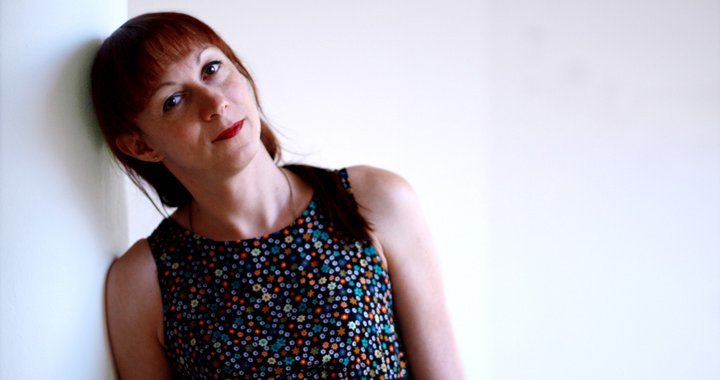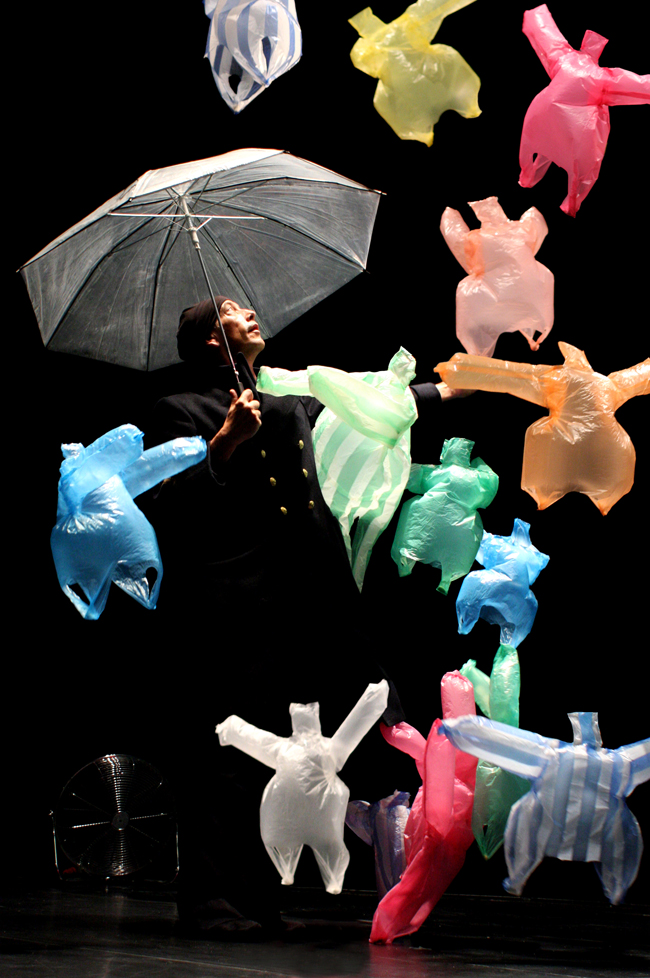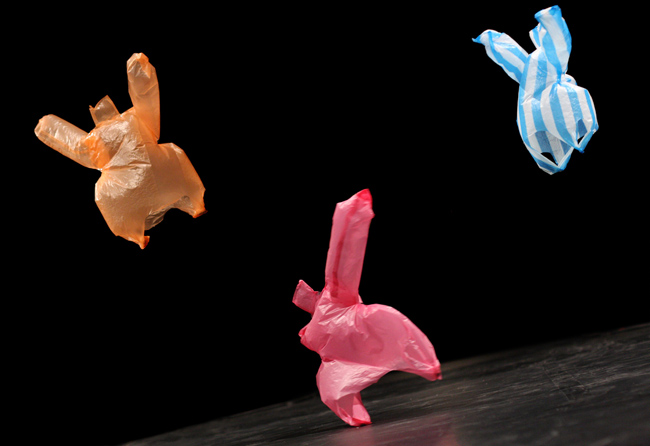
Manipulating life in order to find balance
A conversation with French artist and director Phia Menard
Māra Pāvula
22/08/2016
Cie Non Nova will perform during the contemporary circus festival Re Riga! on 23 and 24 August, showcasing the performance “Windy Afternoon”, as written by French performer and director Phia Menard. This is not Menard's first time in Latvia – 19 years ago she was here as one of the jugglers in the first contemporary circus performance of “Hic Hoc”, by Jerome Thomas. In the following interview, Menard shares her good memories of that time; she also notes that a lot has changed since then. Though this time she is not performing herself, her performance piece will be interpreted in Riga by Jean Louis Ouvrard – someone she wholeheartedly trusts with the fulfillment of her performance in every detail. There is no improvisation as such in her performances; nevertheless, the materials used (air and plastic) will serve as the unexpected element of improvisation. I asked Menard a few questions in an effort to discover the essence of this mysterious French circus director, as well as to learn more about her process of creating such masterpieces.

Cie Non Nova. L’après-midi d’un foehn. Photo: © Jean-Luc Beaujault
How did you become a circus artist? What brought you to this form of expression?
You are asking a question about my roots. I don’t originate from a family of performing artists. I got into the performing arts by what we call in France the democratisation of culture, in which more and more theatres and public dance and circus companies began to appear. I started through this NGO environment, which is where I started to learn to juggle, and little by little, it became my profession. I have to give special thanks to the people I met and who, subsequently, became my masters – notably, Jerome Thomas.
What is your relationship with juggling nowadays?
Even if I juggle very little today, when I take the balls in my hands, for example, I feel that I was taught by those objects.
We have all become jugglers; we manipulate our lives to keep balance. Juggling – it means keeping the balance. In my performances today, even in the theatre pieces I write, I notice that I actually work a lot with keeping the balance between certain objects on the stage.

Cie Non Nova. L’après-midi d’un foehn. Photo: © Jean-Luc Beaujault
You started out as a juggler, but your performances include very different disciplines. How did interdisciplinarity gain such prominence in your work?
I think that the real question, the identity issue, that I work a lot on, is very connected with the idea of transforming oneself. Basically, we are adding more and more new elements to ourselves; we integrate them and we become heterogeneous. And the same goes for my writing. Sometimes I am a bit of a pirate. I use everything to express myself. In fact, I have never deliberately tried to be interdisciplinary – it imposed itself on me and my work. It is interesting because we escape labels. I do not know how it is in Latvia, but in France we like to categorize everything. We absolutely need to put labels on everything because we are very much a moralist society. It is an interesting way for me to question society.
Knowing that a circus can be called both anything and nothing at times, do you feel that the contemporary circus liberates you from those labels?
Yes, but I guess one should not look at this question from one's particular perspective. Often we ask ourselves if the audience comes to the circus because it has been liberated from the many codes [of traditional circuses]. But I don’t think so. I think that a spectator of a contemporary circus has so much less a priori knowledge than a spectator of theatre or dance. He is more uncertain about definition and form. And another important thing – it is much easier to invite people to a circus performance; they are less afraid of not understanding it. It is neither a good nor a bad thing; it’s just how it is. But it means that we – circus and other interdisciplinary artists – have to understand if the audience is ready or not. Therefore, we need to create something intriguing, propose a new viewpoint, bring in other viewpoints, bring in critique and desires.

Cie Non Nova. L’après-midi d’un foehn. Photo: © Jean-Luc Beaujault
What inspired you to work on this particular piece? Was it the theme that suggested that you work with plastic bags, or did the material itself inspire the story?
I work a lot with crosschecking so that I can reflect on a subject from different viewpoints. Anyway, for me, the subject always comes first. I start working only when the subject imposes itself on me and I can’t get it out of me. In such cases, I trust my instincts.
In general, challenging subjects are usually connected with something living. And I have no idea why, but I perceive this something, and it brings me to work with a particular object. In the case of plastic bags – I return to them often. They hold great symbolic value. We live in a society of oil: the whole of society runs on oil, the entire economy functions around it, everything is ruled by oil. So, for me, the plastic bag has an extremely strong symbolic meaning.
When I was creating the first version of the performance “Windy Afternoon”, I was in the Museum of Natural History when I realized that this museum is actually a cemetery. I understood that this is a place where a human being shows what has he destroyed, dominated and dumped, and it is quite terrible at times. It is as if we are showcasing hunting trophies on a permanent basis. But at the same time, I was asking myself about the existence of humans who invented the tools that have brought them this far. From manual mechanization and agriculture, to a sudden overuse of petroleum that has taken over society. Meanwhile, we see the pollution and everything else that comes with it. So, I was interested in reminding people that this material we call plastic, with all its horrifying public image, also has its own beauty. To remind everyone of this global schizophrenia of ours – that we all would like to save the planet, but that means changing our lifestyles. And we can’t get there. We dream of changing the planet without having to do anything whatsoever. This is what I see in plastic.

Cie Non Nova. L’après-midi d’un foehn. Photo: © Jean-Luc Beaujault
Do you consider this performance to be a story that is told by you, or is it more of an experience to be embodied by each viewer individually?
Of course, telling the story is always at the core of it. But then again, this story is very open for interpretation and questioning. The audience never expects the end to be so violent. Somehow, the fact that we go from birth, beauty and grace to death, and so suddenly, makes us face the essential question: Who are we?
When I was creating this piece and I was in the museum, I wanted to bring something to life. I couldn’t bring an animal back to life, but I could try to give life to an object. There was a stuffed zebra there, and by bringing a plastic bag to life, the marionette that I created danced between its legs. And it seemed almost like the zebra wasn’t dead – just fascinated by what was going on, gazing at the dancing marionette. After creating the piece, it turned out that the marionette I had created had robbed me of everything that had been transmitted to me as an artist: grace, technicality, beauty, endurance. And the audience was only looking at the marionette. Indeed, in the end, when the artist destroys those little marionettes, it is because he needs to appropriate what has taken him so much time to learn. It is an act of jealousy.